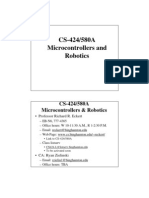0 ratings0% found this document useful (0 votes)
144 viewsComparch 2 PDF
Comparch 2 PDF
Uploaded by
Adam Iglesia Ücontrol system
Copyright:
© All Rights Reserved
Available Formats
Download as PDF, TXT or read online from Scribd
Comparch 2 PDF
Comparch 2 PDF
Uploaded by
Adam Iglesia Ü0 ratings0% found this document useful (0 votes)
144 views33 pagescontrol system
Original Title
comparch-2.pdf
Copyright
© © All Rights Reserved
Available Formats
PDF, TXT or read online from Scribd
Share this document
Did you find this document useful?
Is this content inappropriate?
control system
Copyright:
© All Rights Reserved
Available Formats
Download as PDF, TXT or read online from Scribd
Download as pdf or txt
0 ratings0% found this document useful (0 votes)
144 views33 pagesComparch 2 PDF
Comparch 2 PDF
Uploaded by
Adam Iglesia Ücontrol system
Copyright:
© All Rights Reserved
Available Formats
Download as PDF, TXT or read online from Scribd
Download as pdf or txt
You are on page 1of 33
The Microprocessor Revolution
Mainframe / Scalar Supercomputer
CPU consists of multiple components
performance improving at 20-35% p.a.
often ECL or other exotic technology
huge I/O and memory bandwidth
Microprocessors
usually a single CMOS part
performance improving at 35-50% p.a.
enabled through improvements in fabrication technology
1
huge investment
physical advantages of smaller size
General Purpose Processors
desktop / server
SMP / Parallel supercomputers
Embedded controllers / SoCs
DSPs / Graphics Processors
Developments in CMOS
Fabrication line size reduction
0.8, 0.5, 0.35, 0.25, 0.18, 0.15, 0.13, 0.09
10-20% reduction p.a.
switching delay reduces with line size
increases in clock speed
Pentium 66Mhz @ 0.8, 150Mhz @ 0.6, 233MHz @
0.35
density increases at square of 1/line size
Die size increases at 10-29% p.a.
Transistor count increase at 55% p.a.
2
enables architectural jumps
8, 16, 32, 64, 128 bit ALUs
large caches
PA-8500: 1.5MB on-chip
new functional units (e.g. multiplier)
duplicated functional units (multi-issue)
whole System On a Chip (SoC)
Developments in DRAM Technology
DRAM density
increases at 40-60% p.a.
equivalent to 0.5-1 address bits p.a.
cost dropping at same rate
16M, 64M, 256M, 1G
Consequences for processor architectures:
May not be able to address whole of memory from a single
pointer
segmentation
3
May run out of physical address bits
banked (windowed) memory
DRAM performance
just 35% latency improvement in 10 years!
new bus interfaces make more sequential b/w available
SDRAM, RAMBUS, DDR, DDR2
processor Development Cycle
Fabrication technology has huge inuence on power and
performance
must use the latest fabrication process
Full custom design vs. semi custom
Keep development cycle short (3-4 years)
Non CMOS technology leads to complications
Advance teams to research:
process characteristics
4
key circuit elements
packaging
oor plan
required performance
microarchitecture
investigate key problems
Hope ISA features dont prove to be a handicap
Keep up or die!
Alpha architects planned for 1000x performance
improvement over 25 years
Power Consumption
Important for laptops, PDAs, mobile phones, set-top boxes,
etc.
155W for Digital Alpha 21364 @ 1150MHz
130W for Itanium-2 @ 1500MHz
90W for AMD Opteron 148 @ 2GHz
81W for Pentium-IV @ 3GHz
12W for Intel Mobile Pentium M @ 1100Hz
420mW for Digital StrongArm @ 233MHz, 2.0V
5
130mW for Digital StrongArm @ 100MHz, 1.65V
Smaller line size results in lower power
lower core voltage, reduced capacitance
greater integration avoids inter-chip signalling
Reduce clock speed to scale power
P = CV
2
f
may allow lower voltage
potential for cubic scaling
better than periodic HALTing
Performance per Watt
Dynamic Clock Gating
Divide chip into a hundred or more clock zones,
Only clock a zone when a clock cycle will change a registered value,
Can save a factor of four power, even under heavy CPU load.
always @(posedge gated_clk) begin
r1 <= a + b;
r2 <= ...
end
wire clock_needed = r1 != (a+b) || ... || ... ...;
CLOCKGATECELL g1(gated_clk, clk, clock_needed);
6
Cost and Price
E.g.:
$0.50: 8bit micro controller
$3: XScale (ARM)
(400MHz, 0.18m, 20mm
2
, 2.1M[1M])
$500: Pentium IV Celeron
(1.2GHz, 0.13m, 131mm
2
, 28M[4M])
$150: Pentium IV
(3.2GHz, 0.09m, 180mm
2
, 42M[7M])
$2200: Itanium2
(1Ghz, 0.18m, 421mm
2
, 221M[15M])
Costs inuenced by die size, packaging, testing
7
Large inuence by manufacturing volume
Costs reduce over product life (e.g. 40% p.a.)
Yield improves
Speed grade binning
Fab shrinks and steppings
Compatibility
Pin Compatibility (second sourcing)
Backwards Binary Compatibility
8086, 80286, 80386, 80486, Pentium,
Pentium Pro, Pentium II/III/IV, Itanium
NexGen, Cyrix, AMD, Transmeta
typically need to re-optimize
Typically hard to change architecture
Users have huge investment in s/w
Binary translators e.g. FX!32, WABI
8
typically interface to native OS
Need co-operation from s/w vendors
multi-platform support costs $s
Most computer sales are upgrades
Platform independence initiatives
Source, p-Code, JAVA bytecode, .NET
Compatibility is very important
Performance Measurement
Try before you buy! (often not possible)
System may not even exist yet
use cycle-level simulation
Real workloads often hard to characterize and measure
improvements
especially interactive
Marketing hype
MHz, MIPS, MFLOPS
9
Algorithm kernels
Livermore Loops, Linpack
Synthetic benchmarks
Dhrystones, Whetstones, iCOMP
Benchmark suites
SPEC-INT, SPEC-FP, SPEC-HPC, NAS
Application Benchmarks
TPC-C/H/R, SPECNFS, SPECWeb, Quake
Performance is application dependent
Standard Performance Evaluation
Corporation
SPEC is most widely used benchmark
processor manufactures
workstation vendors
CPU INT / FP 89, 92, 95, 2000, (2004)
Suite updated to reect current workloads
CINT95/2K: 8/12 integer C programs
CFP95/2K: 10/14 oating point in C&Fortran
10
measures:
processor
memory system
compiler
NOT OS, libc, disk, graphics, network
Choosing programs for SPEC2000
More programs than SPEC95
Bigger programs than SPEC95
Dont t in on-chip caches
Reect some real workloads
Run for several minutes
Amortize startup overhead & timing inaccuracies
Not susceptible to trick transformations
Vendors invest huge s/w eort
11
Fit in 256MB (95 was 64MB)
Moving target...
SPEC92, 95, 2K results not translatable
CINT95 suite (C)
099.go An AI go-playing program
124.m88ksim A chip simulator for the Motorola 88100
126.gcc Based on the GNU C compiler version 2.5.3
129.compress An in-memory version of the utility
130.li Xlisp interpreter
132.ijpeg De/compression on in-memory images
134.perl An interpreter for the Perl language
147.vortex An object oriented database
CFP95 suite (Fortran)
101.tomcatv Vectorized mesh generation
102.swim Shallow water equations
103.su2cor Monte-Carlo method
104.hydro2d Navier Stokes equations
107.mgrid 3d potential eld
110.applu Partial dierential equations
125.turb3d Turbulence modelling
141.apsi Weather prediction
145.fpppp Quantum chemistry
146.wave5 Maxwells equations
12
SPEC reporting
Time each program to run
Reproduceability is paramount
Take mean of 3 runs
Full disclosure
Baseline measurements
SPECint base95
Same compiler optimizations for whole suite
Peak measurements
13
SPECint95
Each benchmark individually tweaked
Unsafe optimizations can be enabled!
Rate measurements for multiprocessors
SPECint rate95, SPECfp rate95
time for N copies to complete x N
Totalling Results
How to present results?
Present individual results?
Arithmetic mean?
Weighted harmonic mean?
SPEC uses Geometric mean, normalised against a
reference platform
allows normalization before or after mean
performance ratio can be predicted by dividing means
SPEC95 uses Sun SS10/40 as reference platform
14
spec
SPEC CINT95 Results
Copyright 1995, Standard Performance Evaluation Corporation
34 Volume: 7 Issue: 4
SPECint95
SPECint_base95
8.09
8.09
=
=
Intel Corporation
Alder System (200MHz, 256KB L2)
SPEC license # 14 Tested By: Intel Test Date: Oct-95 Hardware Avail: May-96 Software Avail: Feb-96
Contact:
Information
For More
Manassas, VA 22110
10754 Ambassador Drive, Suite 201
SPEC
http://www.specbench.org
info@specbench.org
(703) 331-0180
S
P
E
C
r
a
t
i
o
0
1
2
3
4
5
6
7
8
9
10
099.go 124.m88ksim 126.gcc 129.compress 130.li 132.ijpeg 134.perl 147.vortex
Alder System (200MHz, 256KB L2)
Hardware/Software Configuration for:
Hardware
Alder Model Name:
200MHz Pentium Pro Processor CPU:
Integrated FPU:
1 Number of CPU(s):
8KBI+8KBD Primary Cache:
256KB(I+D) Secondary Cache:
None Other Cache:
128MB (60ns fast page) Memory:
2GB ST32550W Disk Subsystem:
AHA-2940W Controller Other Hardware:
Software
UnixWare 2.0, SDK Operating System:
Intel C Reference Compiler 2.2 Beta Compiler:
ufs, vxfs (/tmp as 8MB /tmpfs) File System:
Single user (root + killall) System State:
Benchmark
# and Name
Reference
Time
Base
Run Time
Base
SPEC Ratio Run Time SPEC Ratio
SPECint95 (G. Mean) 8.09
SPECint_base95 (G. Mean) 8.09
4600 567 567 8.11 8.11
099.go
1900 243 243 7.81 7.81
124.m88ksim
1700 222 222 7.65 7.65
126.gcc
1800 258 258 6.99 6.99
129.compress
1900 220 220 8.62 8.62
130.li
2400 285 285 8.43 8.43
132.ijpeg
1900 232 232 8.21 8.21
134.perl
2700 295 295 9.14 9.14
147.vortex
Notes/Tuning Information
Base and non-base flags are the same and use Feedback Directed Optimization
Pass1: -tp p6 -ipo -xi -prof_gen -ircdb_dir /tmp/IRCDB
Pass2: -tp p6 -ipo -xi -prof_use -ircdb_dir /tmp/IRCDB
-ircdb_dir is a location flag and not an optimization flag
Portability: 124: -DSYSV -DLEHOST 130, 134, 147: -lm 132: -DSYSV 126: -lm -lc -L/usr/ucblib -lucb -lmalloc
Memory subsystem is four-way interleaved.
SPEC CINT95 Results
Copyright 1995, Standards Performance Evaluation Corporation
-- Prepared By: --
SPECint95
SPECint_base95
--
6.37
=
=
Intel 440LX motherboard
Pentium Pro 200
SPEC license # 1178 Tested By: Ian Pratt, CUCL Test Date: Date Hardware Avail: Date Software Avail: Date
contact
Information
For More
Fairfax, VA 22031
2722 Merrilee Drive, Suite 200
SPEC c/o NCGA
spec-ncga@cup.portal.com
(703) 698-9604 ext 318
S
P
E
C
r
a
t
i
o
0
1
2
3
4
5
6
7
8
099.go 124.m88ksim 126.gcc 129.compress 130.li 132.ijpeg 134.perl 147.vortex
Pentium Pro 200
Hardware/Software Configuration for:
Hardware
Intel 440LX Model Name:
Pentium Pro 200 CPU:
FPU:
1 Number of CPU(s):
8KB+8KB Primary Cache:
256KB Secondary Cache:
Other Cache:
128MB Memory:
4GB Disk Subsystem:
Other Hardware:
Software
Linux 20.0.30 Operating System:
gcc 2.7.2p Compiler:
ext2 File System:
multiuser System State:
Benchmark
# and Name
Reference
Time
Base
Run Time
Base
SPEC Ratio Run Time SPEC Ratio
SPECint95 (G. Mean) --
SPECint_base95 (G. Mean) 6.37
4600 -- 595 -- 7.73
099.go
1900 -- 310 -- 6.12
124.m88ksim
1700 -- 276 -- 6.16
126.gcc
1800 -- 357 -- 5.04
129.compress
1900 -- 277 -- 6.85
130.li
2400 -- 384 -- 6.26
132.ijpeg
1900 -- 279 -- 6.81
134.perl
2700 -- 427 -- 6.32
147.vortex
Notes/Tuning Information
Portability flags were:
Baseline flags were: -O2 -fomit-frame-pointer
Nonbase flags were:
Standard Performance Evaluation Corporation
info@spec.org
http://www.spec.org
spec
CINT2000 Result
Copyright 1999-2000, Standard Performance Evaluation Corporation
Compaq Computer Corporation
AlphaServer ES40 Model 6/833
SPECint2000 =
SPECint_base2000 =
544
518
SPEC license #: 2 Tested by: Compaq NH Test date: Oct-2000 Hardware Avail: Jan-2001 Software Avail: Nov-2000
Benchmark
Reference
Time
Base
Runtime
Base
Ratio Runtime Ratio
200 400 600 800
164.gzip 1400 358 392 357 393
175.vpr 1400 309 452 307 456
176.gcc 1100 178 617 160 687
181.mcf 1800 408 441 340 529
186.crafty 1000 144 694 157 637
197.parser 1800 500 360 409 440
252.eon 1300 202 645 202 644
253.perlbmk 1800 342 526 332 543
254.gap 1100 301 365 303 363
255.vortex 1900 282 673 249 763
256.bzip2 1500 268 560 264 568
300.twolf 3000 456 658 451 666
Hardware
CPU: Alpha 21264B
CPU MHz: 833
FPU: Integrated
CPU(s) enabled: 1
CPU(s) orderable: 1 to 4
Parallel: No
Primary Cache: 64KB(I)+64KB(D) on chip
Secondary Cache: 8MB off chip
L3 Cache: None
Other Cache: None
Memory: 16GB
Disk Subsystem: 1x8GB BD0096349A
Other Hardware: Ethernet
Software
Operating System: Tru64 UNIX V5.1 + Patch Kit 1 libc
Compiler: Compaq C V6.3-129-44A8I
Compaq C++ V6.2-033-4298H
File System: AdvFS
System State: Multi-user
Notes/Tuning Information
Baseline C : cc -arch ev6 -fast GEMFB ONESTEP
C++: cxx -arch ev6 -O2 ONESTEP
GEMFB: fdo_pre0 = mkdir /tmp/pb; rm -f /tmp/pb/${baseexe}*
PASS1_CFLAGS = -prof_gen_noopt -prof_dir /tmp/pb
PASS2_CFLAGS = -prof_use_feedback -prof_dir /tmp/pb
(base uses directory /tmp/pb; peak uses /tmp/pp)
SPIKEFB: fdo_post2 = spike -feedback ${baseexe} -o tmp ${baseexe};
mv tmp ${baseexe}
Peak: cc [except eon: cxx] -arch ev6 ONESTEP plus:
164.gzip: -g3 -fast -O4 +GEMFB
175.vpr: -g3 -fast -O4 +GEMFB
176.gcc: -g3 -fast -O4 -xtaso_short +GEMFB
181.mcf: -g3 -fast -xtaso_short +GEMFB
186.crafty: -g3 -fast -O4 -inline speed
197.parser: -g3 -fast -O4 -xtaso_short +GEMFB
252.eon: -O2
253.perlbmk: -g3 -fast +GEMFB +SPIKEFB
254.gap: -g3 -fast -O4 +GEMFB
spec
SPEC CINT95rate Results
Copyright 1995, Standard Performance Evaluation Corporation
94 Volume: 7 Issue: 4
SPECint_rate95
SPECint_rate_base95
642
642
=
=
Digital Equipment Corp.
AlphaServer 8400 5/300
SPEC license # 2 Tested By: Digital PKO Test Date: Oct-95 Hardware Avail: Apr-95 Software Avail: Aug-95
Contact:
Information
For More
Manassas, VA 22110
10754 Ambassador Drive, Suite 201
SPEC
http://www.specbench.org
info@specbench.org
(703) 331-0180
SPECrate
0 100 200 300 400 500 600 700 800 900
099.go
124.m88ksim
126.gcc
129.compress
130.li
132.ijpeg
134.perl
147.vortex
AlphaServer 8400 5/300
Hardware/Software Configuration for:
Hardware
AlphaServer 8400 5/300 Model Name:
300 MHz 21164 CPU:
Integrated FPU:
10 Number of CPU(s):
8KBI+8KBD on chip Primary Cache:
4MB Secondary Cache:
none Other Cache:
1GB Memory:
1 x 2GB Disk Subsystem:
1 x 2GB
Ethernet Other Hardware:
Software
Digital UNIX V3.2C (Rev 148) Operating System:
DEC C V5.0-106 Compiler:
UFS File System:
Multi User System State:
Benchmark
# and Name
Base
Copies
Base
Run Time
Base
SPEC Ratio Copies Run Time SPEC Ratio
SPECint_rate95 (G. Mean) 642
SPECint_rate_base95 (G. Mean) 642
10 10 464 464 891 891
099.go
10 10 271 271 631 631
124.m88ksim
10 10 291 291 526 526
126.gcc
10 10 270 270 601 601
129.compress
10 10 280 280 611 611
130.li
10 10 350 350 617 617
132.ijpeg
10 10 257 257 666 666
134.perl
10 10 377 377 645 645
147.vortex
Notes/Tuning Information
Baseline Optimizations: -O5 -ifo -non_shared -om
Portibility Flags: 124.m88ksim: -DLEHOST 134.perl: -DI_TIME
147.vortex: -D__RISC_64__
Compiler invokation: cc -migrate -std1 (DEC C with -std1 for strict ANSI)
Top SPEC2000 Results for each ISA
machine processor cpu MHz cache sizes int fp
Intel D925 Pentium IV-X 3466 12*/8+512+2M 1772 1724
AMD/ASUS Opteron150 2400 64/64+1M 1663 1849
Intel D925 Pentium IV 3600 12*/8+1M 1575 1630
HP rx4640 Itanium2 1600 16/16+256+6M 1590 2612
IBM p570 Power5+ 1900 64/32+2M+(36M) 1453 2733
HP Alpha GS1280 21364 1300 64/64+(2M) 994 1684
Fujitsu SPARC64-V 1350 128+128/2M 905 1340
Apple PPC970 (G5) 2000 64/32+512 800 840
HP Pentium-M 1000 32/32+1024 687 552
HP c3750 PA-8700 875 768/1.5M 678 674
SGI Orgin 3200 R14000 600 32/32+(8M) 500 529
HP rx4610 Itanium 800 16/16+96+(4M) 379 701
15
Selected SPEC95 Results
machine processor cpu MHz cache sizes int base fp base
Sun SS10/40 SuprSP 40 20/16 1.00 1.00
Intel 440BX Pentium II 300 16/16+(512) 12.2 8.4
Intel 440EX Celeron A 300 16/16+128 11.3 8.3
Intel 440EX Celeron 300 16/16 8.3 5.8
Compaq PC164LX 21164 533 8/8+96+(4M) 16.8 20.7
Compaq PC164SX 21164PC 533 16/16+(1M) 12.2 14.1
Intel 440BX Pentium II 450 16/16+(512) 17.2 11.8
Intel 440BX Pentium II 400 16/16+(512) 15.8 11.4
Intel 440BX Pentium II 350 16/16+(512) 13.9 10.2
Intel 440BX Pentium II 330 16/16+(512) 13.0 8.8
Intel 440BX Pentium II 300 16/16+(512) 11.9 8.1
Intel 440BX Pentium II 266 16/16+(512) 10.7 7.5
Intel 440BX Pentium II 233 16/16+(512) 9.4 6.7
DEC 4100/5/400 A21164 400/75 8/8+96+4M 10.1 16.0
DEC 4100/5/400 2xA21164 400/75 8/8+96+4M 10.1 20.7
DEC 4100/5/400 4xA21164 400/75 8/8+96+4M 10.1 26.6
Intel XXpress Pentium 200 8/8+1M 5.47 2.92
Intel Alder PentPro 200 8/8+256 8.09 5.99
16
Comparing Implementations Summary
Fabrication technology has a huge inuence
Exponential improvement in technology
Processor for a product chosen on:
Instruction Set Compatibility
Power Consumption
Price
Performance
Performance is application dependent
17
Avoid MIPS, MHz
Benchmark suites
You might also like
- @TradersLibrary2 The 30 Minute Stock Trader by Laurens Bensdorp PDFDocument161 pages@TradersLibrary2 The 30 Minute Stock Trader by Laurens Bensdorp PDFAbha Patel100% (10)
- Augustine On The TrinityDocument265 pagesAugustine On The TrinityAnton Toth100% (9)
- Arm Cortex-A9 Mpcore Processor: Presented byDocument25 pagesArm Cortex-A9 Mpcore Processor: Presented byJawwad RafiqNo ratings yet
- History and Philosophy of EducationDocument17 pagesHistory and Philosophy of EducationFelipe Ortego60% (5)
- What Is Strategic ThinkingDocument6 pagesWhat Is Strategic ThinkingMarco AlvarezNo ratings yet
- High Performance Computing - Benchmarks: DR M. ProbertDocument30 pagesHigh Performance Computing - Benchmarks: DR M. ProbertAntônio ArapiracaNo ratings yet
- CH 1Document55 pagesCH 1Wei-Lun HuangNo ratings yet
- "Iron Law" of Processor Performance: Prof. R. Iris Bahar EN164 January 31, 2007Document4 pages"Iron Law" of Processor Performance: Prof. R. Iris Bahar EN164 January 31, 2007Charan Pratap SinghNo ratings yet
- 722 9 5 2011 ReviewDocument101 pages722 9 5 2011 Reviewmbscribd2011No ratings yet
- Introduction To Reconfigurable Systems1Document45 pagesIntroduction To Reconfigurable Systems1sahebzamaniNo ratings yet
- 4104euen PLC Overview 0Document64 pages4104euen PLC Overview 0ludek_bartakNo ratings yet
- MSP430 Update PresentationDocument118 pagesMSP430 Update PresentationNguyên ThảoNo ratings yet
- DR Tahir Zaidi: Targets For AlgorithmsDocument37 pagesDR Tahir Zaidi: Targets For AlgorithmsBilal AwanNo ratings yet
- PDSP ArchitectureDocument95 pagesPDSP ArchitecturekrajasekarantutiNo ratings yet
- L23 - Computational Issues: Data Must Be Shared Between Disciplines More Easily Computational Requirements IncreaseDocument5 pagesL23 - Computational Issues: Data Must Be Shared Between Disciplines More Easily Computational Requirements Increasefrancisco_barboza_1No ratings yet
- Qualcomm Hexagon ArchitectureDocument23 pagesQualcomm Hexagon ArchitectureRahul SharmaNo ratings yet
- Computer ArchitecutreDocument77 pagesComputer ArchitecutreBalaji McNo ratings yet
- Genaral Catalog PLC PanasonicDocument36 pagesGenaral Catalog PLC Panasonicpeter08068350% (2)
- Tms 320 F 28379 DDocument215 pagesTms 320 F 28379 DadnantanNo ratings yet
- 64-Bit Versus 32-Bit Cpus in Scientific Computing: Axel KohlmeyerDocument27 pages64-Bit Versus 32-Bit Cpus in Scientific Computing: Axel KohlmeyertasaddaqNo ratings yet
- ACA UNit 1Document29 pagesACA UNit 1mannanabdulsattarNo ratings yet
- Delta Ia-Plc As C en 20210916Document56 pagesDelta Ia-Plc As C en 20210916Diana Amaya NatividadNo ratings yet
- 28 PLC QuantumDocument335 pages28 PLC Quantumnamhts100% (1)
- Reduced Instruction Set Computers: William Stallings Computer Organization and Architecture 7 EditionDocument38 pagesReduced Instruction Set Computers: William Stallings Computer Organization and Architecture 7 EditionSaimo FortuneNo ratings yet
- Datasheet PDFDocument213 pagesDatasheet PDFRoshan PradhanNo ratings yet
- LT SpiceDocument39 pagesLT SpiceKot FareNo ratings yet
- A Systolic FFT Architecture For Real Time FPGA SystemsDocument33 pagesA Systolic FFT Architecture For Real Time FPGA SystemshariharankalyanNo ratings yet
- Sam D5X/E5X Family Data Sheet: 32-Bit Arm Cortex - M4F Mcus With 1 Msps 12-Bit Adc, Qspi, Usb, Ethernet, and PTCDocument2,129 pagesSam D5X/E5X Family Data Sheet: 32-Bit Arm Cortex - M4F Mcus With 1 Msps 12-Bit Adc, Qspi, Usb, Ethernet, and PTCJ. MaruggNo ratings yet
- Sam D5X/E5X Family Data Sheet: 32-Bit Arm Cortex - M4F Mcus With 1 Msps 12-Bit Adc, Qspi, Usb, Ethernet, and PTCDocument2,129 pagesSam D5X/E5X Family Data Sheet: 32-Bit Arm Cortex - M4F Mcus With 1 Msps 12-Bit Adc, Qspi, Usb, Ethernet, and PTCJ. MaruggNo ratings yet
- 2019 PS REGUL Catalog Eng Preview2 PDFDocument58 pages2019 PS REGUL Catalog Eng Preview2 PDFПавел ПавловNo ratings yet
- EE (CE) 6304 Computer Architecture Lecture #2 (8/28/13)Document35 pagesEE (CE) 6304 Computer Architecture Lecture #2 (8/28/13)Vishal MehtaNo ratings yet
- Pentium Processor: N N N NDocument70 pagesPentium Processor: N N N NMartu LoloNo ratings yet
- Smc10Gpcie-10Bt: Tiger Card™ 10G Pcie 10gbe 10Gbase-T Server AdapterDocument2 pagesSmc10Gpcie-10Bt: Tiger Card™ 10G Pcie 10gbe 10Gbase-T Server Adapterpepe2000No ratings yet
- dsPIC33CK256MP508 Family Data Sheet DS70005349HDocument640 pagesdsPIC33CK256MP508 Family Data Sheet DS70005349HZoran ConstantinescuNo ratings yet
- sprs881d - TMS320F2837xS Delfino™ MicrocontrollersDocument214 pagessprs881d - TMS320F2837xS Delfino™ MicrocontrollersRakesh SandarativjuNo ratings yet
- The 8051 Microcontroller: Prepared By, R-Thandaiah PrabuDocument46 pagesThe 8051 Microcontroller: Prepared By, R-Thandaiah PrabushankarsahniNo ratings yet
- Intel Overclocking GuideDocument36 pagesIntel Overclocking Guidemohit616No ratings yet
- Lin Zhong Seminar SlidesDocument77 pagesLin Zhong Seminar SlidesUCSBieeNo ratings yet
- CIS775: Computer Architecture: Chapter 1: Fundamentals of Computer DesignDocument43 pagesCIS775: Computer Architecture: Chapter 1: Fundamentals of Computer DesignPranjal JainNo ratings yet
- Delta Ia-Plc As C en 20220427Document56 pagesDelta Ia-Plc As C en 20220427Ruben Mondejar MaciánNo ratings yet
- Delta Ia-Plc As C en 20240104Document64 pagesDelta Ia-Plc As C en 20240104GustavoNo ratings yet
- Delta Ia-Plc As C en 20240812Document64 pagesDelta Ia-Plc As C en 20240812Silas SoaresNo ratings yet
- Digital SystemsDocument45 pagesDigital SystemsSindhu ManchukondaNo ratings yet
- Tms 320 F 28379 DDocument222 pagesTms 320 F 28379 DJuan Ku LosanoNo ratings yet
- CS-424/580A Microcontrollers & RoboticsDocument21 pagesCS-424/580A Microcontrollers & Roboticsprabhuswamiji6160No ratings yet
- Delta Ia-Plc As C en 20230116Document64 pagesDelta Ia-Plc As C en 20230116GabrielNo ratings yet
- DSP Cores vs. ChipsDocument189 pagesDSP Cores vs. ChipsARAVINDNo ratings yet
- Class Delta Ia-Plc As C en 20220928Document62 pagesClass Delta Ia-Plc As C en 20220928lakshman_ksrlNo ratings yet
- EE6304 Lecture13 ProcessorsDocument69 pagesEE6304 Lecture13 ProcessorsAshish SoniNo ratings yet
- dm3730 TRMDocument280 pagesdm3730 TRMVenkatakishore ChNo ratings yet
- 633888485056270520Document115 pages633888485056270520rafeshNo ratings yet
- LS-DYNA AnalysisDocument29 pagesLS-DYNA AnalysisJohn TerryNo ratings yet
- Lecture1 2Document30 pagesLecture1 2Sundar RajanNo ratings yet
- William Stallings Computer Organization and Architecture 8 EditionDocument38 pagesWilliam Stallings Computer Organization and Architecture 8 EditionNEOROVENo ratings yet
- Bga900c80p30x30 2500X2500X355 Ti Fcbga CMS S-Pbga-N900 PDFDocument298 pagesBga900c80p30x30 2500X2500X355 Ti Fcbga CMS S-Pbga-N900 PDFMohan K SNo ratings yet
- Embedded LaboratoryDocument95 pagesEmbedded LaboratoryRajkumar kkNo ratings yet
- 2 SPCDocument79 pages2 SPCRNo ratings yet
- LAN7430 LAN7431 Data - Sheet DS00002631B 1534924Document78 pagesLAN7430 LAN7431 Data - Sheet DS00002631B 1534924Tiago DutraNo ratings yet
- CUDA 4 1 Webinar v11-11-22Document41 pagesCUDA 4 1 Webinar v11-11-22Sam Singh100% (1)
- Es Unit1Document83 pagesEs Unit1venneti kiranNo ratings yet
- PLC: Programmable Logic Controller – Arktika.: EXPERIMENTAL PRODUCT BASED ON CPLD.From EverandPLC: Programmable Logic Controller – Arktika.: EXPERIMENTAL PRODUCT BASED ON CPLD.No ratings yet
- Chemistry QuestionDocument2 pagesChemistry QuestionAdam Iglesia ÜNo ratings yet
- User Manual: "Uspeech"Document3 pagesUser Manual: "Uspeech"Adam Iglesia ÜNo ratings yet
- PL2303 Windows Driver User Manual v1.10.0Document21 pagesPL2303 Windows Driver User Manual v1.10.0Adam Iglesia ÜNo ratings yet
- 5.1.4.4 Packet Tracer - StudentDocument3 pages5.1.4.4 Packet Tracer - StudentAdam Iglesia Ü0% (1)
- Dominique Adam M. Iglesia 6/18/14 Revolution of MicroprocessorDocument4 pagesDominique Adam M. Iglesia 6/18/14 Revolution of MicroprocessorAdam Iglesia ÜNo ratings yet
- Poems To MemorizeDocument5 pagesPoems To MemorizeJULIO MANUEL OLIVARESNo ratings yet
- Reading List 2007Document9 pagesReading List 2007irineugianesiNo ratings yet
- Tom Ford Research PaperDocument6 pagesTom Ford Research Paperh01xzacm100% (1)
- Adaptation in Animals-Ppt 2Document15 pagesAdaptation in Animals-Ppt 2ARNAB GHOSH CLASS VNo ratings yet
- Case Based Learning in Orthodontic Undergraduate EducationDocument11 pagesCase Based Learning in Orthodontic Undergraduate EducationZubair AhmedNo ratings yet
- Scooptram ST1520LP: Atlas CopcoDocument4 pagesScooptram ST1520LP: Atlas CopcosamuelahpNo ratings yet
- Med Case StudyDocument113 pagesMed Case Studyczeremar chanNo ratings yet
- Extra Ordinary Gazette Date: 15.11.2019 Last Date: 18.12.2019 CATEGORY NO: 192/2019Document5 pagesExtra Ordinary Gazette Date: 15.11.2019 Last Date: 18.12.2019 CATEGORY NO: 192/2019trismaheshNo ratings yet
- European Patent Specification B64C 27/32: Printed by Jouve, 75001 PARIS (FR)Document12 pagesEuropean Patent Specification B64C 27/32: Printed by Jouve, 75001 PARIS (FR)Amir BahramiNo ratings yet
- ACA Syllabus PDFDocument2 pagesACA Syllabus PDFPrakhyath JainNo ratings yet
- Open Price Close PriceDocument3 pagesOpen Price Close Priceanita mahajanNo ratings yet
- Heinkel Flyer Classifying Centrifuge v630 BK TiocentDocument2 pagesHeinkel Flyer Classifying Centrifuge v630 BK TiocentRaghNo ratings yet
- Adamczyk Resume 2019 5Document2 pagesAdamczyk Resume 2019 5api-511630954No ratings yet
- Cimco HSMUser Guide A5 WebDocument77 pagesCimco HSMUser Guide A5 WebBartosz SieniekNo ratings yet
- Math FunctionDocument2 pagesMath FunctionSushant VanveNo ratings yet
- Transaction Management and Concurrency ControlDocument34 pagesTransaction Management and Concurrency ControlJoann GalopoNo ratings yet
- HRM2601Document5 pagesHRM2601Andre De BeerNo ratings yet
- Daftar Produk CEUDocument1 pageDaftar Produk CEUZulfan STNo ratings yet
- The Descriptor Differential Scale of Pain Intensity: An Evaluation of Item and Scale PropertiesDocument10 pagesThe Descriptor Differential Scale of Pain Intensity: An Evaluation of Item and Scale PropertiesOlavo BrilhanteNo ratings yet
- Incentive SpirometryDocument5 pagesIncentive Spirometryrachelmores12No ratings yet
- Unit 7 Mother NatureDocument15 pagesUnit 7 Mother NatureSainah ManigothNo ratings yet
- My Bondage and My Freedom by Frederick Douglass - PDF RoomDocument108 pagesMy Bondage and My Freedom by Frederick Douglass - PDF RoomGeorge OfordileNo ratings yet
- Connotation (Or "Extended/symbolic Meaning"), of Many of The Ideas Being Expressed, FromDocument14 pagesConnotation (Or "Extended/symbolic Meaning"), of Many of The Ideas Being Expressed, FromLivanur ErbilNo ratings yet
- Medica EasyLyte BrochureDocument6 pagesMedica EasyLyte BrochureaoxoxzNo ratings yet
- Chemistry of The Elements (2nd Edition)Document14 pagesChemistry of The Elements (2nd Edition)mycomiccityNo ratings yet
- Modern ABC+of Chemistry X Ch1 3Document139 pagesModern ABC+of Chemistry X Ch1 3shilomerciNo ratings yet






























































































